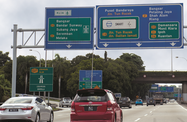Malaysia has announced plans to boost its automotive sector through the production of electric cars, hoping to both develop a lucrative export trade while actively combating carbon emissions at home. The industry will face competition, however, from other countries in the region whose green automotive initiatives are more developed.
At present, there are 11 completely electric vehicles on Malaysia’s roads, according to government figures. Hybrid cars – which use both conventional fuel and an alternative power source for their engines – are more popular, with around 8000 hybrid vehicles currently on the roads.
This is set to change, however, with the government planning to announce a major policy shift that will promote the production and domestic use of electric vehicles. The highly anticipated revision of the National Automotive Policy (NAP), the government’s long-term plan for the industry, will introduce several new reforms and regulations.
Since late 2011, the Malaysian government has been promoting the establishment of a local electric vehicle manufacturing capacity. Both the government and industry lobby groups believe such a move will help broaden the base of the sector.
According to projections from the Malaysia Automotive Institute (MAI), reforms to the industry, coupled with higher local and international demand, will see the sector’s contribution to the economy triple by 2020. In a statement issued in early May, the MAI said it expected the industry’s share of GDP to rise from the present rate of 2.4% to 6.8%, largely due to an increased focus on the production of electric and other energy-efficient vehicles. This growth would be underpinned by a higher level of foreign direct investment and government efforts to encourage original equipment manufacturers (OEMs) to set up operations in Malaysia.
“Meeting vehicle standards for energy-efficient vehicles in Malaysia means bringing new technologies into the country,” Madani Sahari, the CEO of the MAI, told OBG. “As a result, OEMs are being targeted. Before this happens, however, the sector must be liberalised by allowing both local and foreign OEMs to qualify for manufacturing licences, which is expected to happen with the pending second revision of the NAP.”
While there is the potential for Malaysia to break into the regional and international market with a locally produced electric car, it will face stiff competition from both China and Thailand, which have established automotive sectors that include electric car production plants.
With this in mind, Malaysian officials are aware of the need to develop a domestic market for electric cars and their hybrid counterparts. In early May, Mustapa Mohamed, the minister of international trade and industry, announced that the government would offer incentives to Malaysians to buy electric or hybrid vehicles. While there is already a 100% import duty exemption for electric or hybrid cars below 2200 cu centimetres, the minister said additional measures would be enacted to promote the use of electric vehicles.
“We will continue to introduce incentives to accelerate the move towards zero-emission mobility,” Mustapa said. “Our goal is to increase the number of hybrid and electric cars on our roads by 10% by 2020. By then, we hope to be living in a much cleaner and greener environment.”
The government is also encouraging private firms to put in place the necessary infrastructure for these vehicles to operate. On May 29, Peter Chin, the minister of energy, green technology and water, said his department was developing regulations and standards for firms that plan to set up charging stations for electric vehicles. Such measures are needed to create an environment that would generate an interest in the use of alternatively powered cars.
“Until we have charging stations, we are not ready. Once the infrastructure is up, then people will be tempted to buy electric vehicles,” Chin said. “If we want to make it commercial, certain infrastructure must be in place, such as credit card facilities for consumers to pay for charging services.”
The minister also said that an electric vehicle infrastructure plan to enable pilot demonstration projects would be a part of the new NAP.
Local and international manufacturers are likely to wait until the latest version of the NAP is released before making any decisions on whether or not to tap into the electric vehicle sector. However, Malaysia-based vehicle producer Proton and Japan-based Nissan and Mitsubishi are all running trials of battery-powered cars in the country to raise awareness of the plug-in option and test their viability.
If Malaysia is to achieve its ambitious target of cutting emissions by 40%, it will need to move quickly to generate industry interest and acceptance of the new product among the public.

